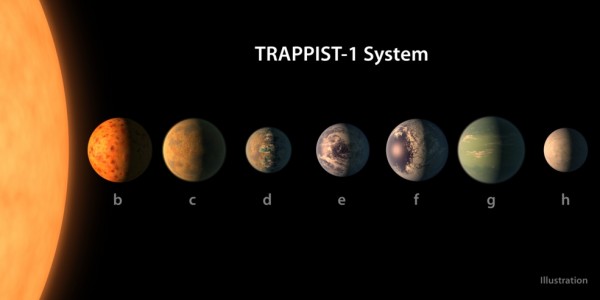By Ana Verayo, | March 06, 2017

This artist's concept shows what each of the TRAPPIST-1 planets may look like, based on available data about their sizes, masses and orbital distances. (NASA/JPL-Caltech)
Scientists say that volcanoes on alien worlds can boost temperatures on icy exoplanets and potentially trigger life. In a new study, scientists say that volcanism on other planets can create liquid water on the surface of these planets.
In a recent NASA discovery, astronomers were able to detect several Earth-like rocky exoplanets known as TRAPPIST-1h. These planets are orbiting a dwarf star which is located 39 light years away from our solar system. Scientists say that if these worlds possess volcanoes, then they could be warm enough to have water.
Like Us on Facebook
Exoplanets that can potentially host life and create water on its surface are also located in the habitable zone of their stellar system. This means that these planets are located not too far or not too near their host star to create the ideal conditions for water to thrive. Apart from water, hydrogen can also exist in their atmosphere, but since it is a very light gas, hydrogen can easily escape into space.
In this new study, scientists suggest that active volcanoes on these exoplanets can change how hydrogen stays in a planet's atmosphere. According to the lead author of the study, Ramses Ramirez of Cornell University, Earth's volcanic, hydrogen-rich habitable zone is different since active volcanism is intense enough that it produces more hydrogen than the amount of hydrogen that escapes into space.
Volcanoes can continuously re-supply a planet with hydrogen for its atmosphere and Cornell University scientists determined that this volcanic activity can increase the habitable zone of a system by 60 percent. Ramirez explained that this increased volcanism could allow potentially habitable conditions for longer geologic timescales.
The existence of this volcanic activity means that an exoplanet in the habitable zone must possess plate tectonics to build its own volcanoes. On Earth, its crust and plate tectonics interact with each other to create lava. On Mars, since gravitational forces are weaker and its crust is one single, massive plate, the volcanic material is less evolved and lava flows often pile up creating massive volcanoes such as the Olympus Mons, which is the largest known volcano in the solar system.
Scientists also predict that alien worlds with thick, hydrogen atmospheres can appear similar to Earth. The team also suggests that early Earth may have possessed a hydrogen-rich atmosphere despite today's atmosphere being 78 percent nitrogen and 21 percent oxygen. If this theory is correct, early Earth may have appeared like these hydrogen-rich exoplanets with active volcanism.
This new study was published in the Astrophysical Journal Letters.
-
Use of Coronavirus Pandemic Drones Raises Privacy Concerns: Drones Spread Fear, Local Officials Say

-
Coronavirus Hampers The Delivery Of Lockheed Martin F-35 Stealth Fighters For 2020

-
Instagram Speeds Up Plans to Add Account Memorialization Feature Due to COVID-19 Deaths

-
NASA: Perseverance Plans to Bring 'Mars Rock' to Earth in 2031

-
600 Dead And 3,000 In The Hospital as Iranians Believed Drinking High-Concentrations of Alcohol Can Cure The Coronavirus

-
600 Dead And 3,000 In The Hospital as Iranians Believed Drinking High-Concentrations of Alcohol Can Cure The Coronavirus

-
COVID-19: Doctors, Nurses Use Virtual Reality to Learn New Skills in Treating Coronavirus Patients







